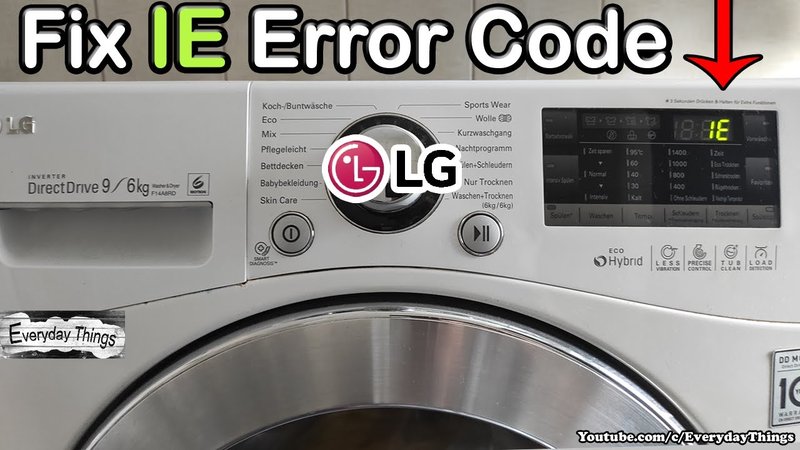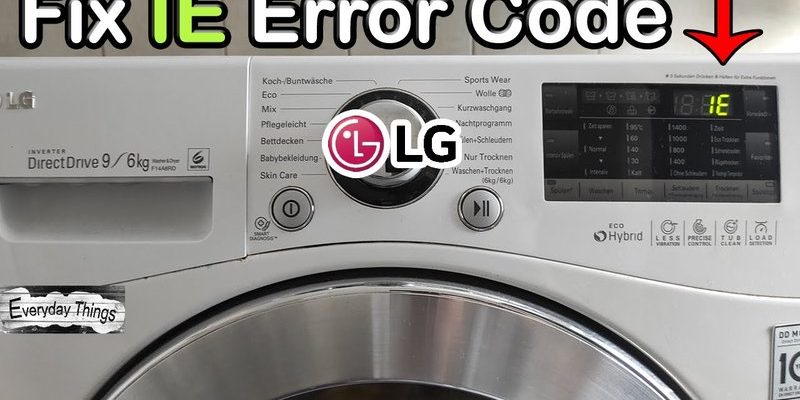
Imagine your washing machine as a well-oiled team, each part playing a key role in the mission of getting your clothes clean. When your team is off balance, the whole operation can come to a grinding halt. That’s what happens when UE pops up. Although resetting the machine might seem like a quick fix, it’s a bit more complex than just turning it off and on again. Let’s break it down further.
Understanding the UE Error Code
The UE error code on an LG washing machine is a signal that the load inside the drum is unevenly distributed. Picture your washing drum as a spinning dancer—if the dancer has weights tied unevenly to one side, they’ll stumble. Similarly, an unbalanced drum struggles to spin smoothly, which is why your washer throws a UE error.
You might be wondering, “Why does this happen?” Well, it can often occur when there are too many clothes loaded on one side, or if there’s a single heavy item among lighter ones. It’s like trying to balance a scale with a bowling ball on one side and feathers on the other. Overloading the machine or washing a single bulky item, such as a large blanket, can also cause this imbalance.
What’s next? The machine senses this imbalance and, to protect itself from damage, it stops running. It’s like a safety measure that prevents further problems. So, if you’re standing there, scratching your head, don’t worry. There are simple steps you can take to fix it beyond just resetting.
Resetting: Is It a Magic Fix?
Turning your washing machine off and on again might feel like the go-to solution for many tech issues, right? But here’s the deal: while resetting can clear the lingering error code from the display, it doesn’t actually fix the root cause of the problem. It’s a bit like putting a band-aid on a bigger issue without dealing with what’s underneath.
When you reset your LG washing machine, you essentially reboot its electronics, clearing out any temporary glitches in the system. It’s akin to restarting your computer when it freezes. However, if you don’t address the unbalanced load, you’ll likely see that UE error pop up again during the next cycle.
So, what can you do instead? Ensure your laundry load is spread evenly in the drum. This could mean rearranging the items to balance the weight or removing a few pieces if you’ve crammed too much in there. You may also need to run a smaller load or adjust the types of items you’re washing together.
Steps to Correct an Unbalanced Load
Dealing with a UE error may feel like a puzzle, but solving it is straightforward. First, stop the machine and open the door—don’t worry, it’s not breaking any rules here. Take out some clothes if it’s overloaded, or redistribute them for a more even spread. Just think of it as spreading peanut butter evenly across a slice of bread.
If the error persists, take a moment to check that your washing machine is level on the floor. Use a spirit level if needed, adjusting the machine’s feet until it stands balanced. Think of this step as ensuring your table doesn’t wobble during dinner—it makes all the difference.
Now, if these steps seem a little tricky, it might be worth peeking into the user manual for tailored advice. Each model has specific guidelines that can be a lifesaver and are usually spot-on in helping you troubleshoot further.
Preventing Future Errors
To avoid seeing that UE error return, here’s a little tip: always distribute your laundry as evenly as possible. Mix and match heavy and light items, rather than washing them all at once. Imagine you’re packing a suitcase—you want everything to fit snugly without shifting around.
Another handy preventative measure is to check pockets for coins or small items that could affect the load distribution as they move around. These can add unexpected weight to one side of the drum, much like a surprise pebble in your shoe.
Finally, regular maintenance checks can do wonders. Every couple of months, inspect the drum and balance settings, ensuring everything runs smoothly. It’s like routinely checking your car’s oil—keeps things smooth and prevents unexpected stops in service.
Remember, just because a quick reset might clear the immediate error, ensuring balanced loads and routine maintenance can save you from frustration down the line. Happy washing!
